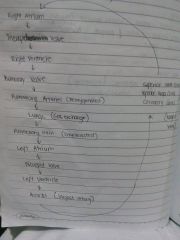![]()
![]()
![]()
Use LEFT and RIGHT arrow keys to navigate between flashcards;
Use UP and DOWN arrow keys to flip the card;
H to show hint;
A reads text to speech;
45 Cards in this Set
- Front
- Back
|
Three interrelated components of Cardiovascular System |
- blood - heart - blood vessels |
|
|
a liquid connective tissue |
Blood |
|
|
water liquid extracellular matrix |
Blood Plasma |
|
|
Formed Elements of Blood Plasma |
- Red Blood Cells - White Blood Cells - Platelets |
|
|
- aka Erythrocytes - contain oxygen-carrying protein hemoglobin - lacks nucleus and other organelles - live only about 120 days |
Red Blood Cells |
|
|
- aka Leukocytes - have nuclei - do not contain hemoglobin - general function to combat invaders by phagocytosis or immune responses |
White Blood Cells |
|
|
Types of white Blood Cells |
Basophils and Eosinophils |
|
|
intensify inflammatory reaction |
Basophils |
|
|
release histaminase |
Eosinophils |
|
|
major soldiers of the immune system |
Lymphocytes |
|
|
bacteria and toxins |
B cells |
|
|
viruses, fungi, transplanted and cancer cells |
T Cells |
|
|
infectious microbes and certain tumor cells |
Natural Killer (NK) Cells |
|
|
- aka Thrombocytes - splinters into 2000-3000 - disc-shaped w/ many vesicles but no nucleus - help stop blood loss by forming platelet plug - 5-9 days life span |
Platelets |
|
|
blood has only Antigen A |
Type A |
|
|
blood has only Antigen B |
Type B |
|
|
- blood has antigens A and B - universal recipients |
Type AB |
|
|
- blood has neither antigen - universal donor |
Type O |
|
|
- located at the mediastinum - apex at tip of the left ventricle - base is posterior surface |
Heart |
|
|
Membrane surrounding and protecting the heart |
Pericardium |
|
|
2 main parts of Pericardium |
- Fibrous - Serous |
|
|
reduces friction; secreted into pericardial cavity |
Pericardial Fluid |
|
|
Layers of the Heart wall |
- Epicardium - Myocardium - Endocardium |
|
|
Smooth, slippery texture to outermost surface |
Epicardium |
|
|
95% of heart is cardiac muscle |
Myocardium |
|
|
Smooth lining for chambers of heart |
Endocardium |
|
|
Chambers of the Heart |
2 atria and 2 ventricles |
|
|
Heart Valve |
- Atrioventricular Valves - Semilunar Valves |
|
|
Atrioventricular Valves |
- Tricuspid Valve - Bicuspid Valve |
|
|
Semilunar Valves |
- Aortic Valve - Pulmonary Valve |
|
|
Bicuspid Valve Strings |
Chordae Tendinae |
|
|
Specialized Cardiac Muscle Fibers |
Autorhythmic Fibers |
|
|
acts as pacemaker of the heart |
Sinoatrial Node |
|
|
5 main types of Blood Vessels |
- Arteries - Arterioles - Capillaries - Venules - Veins |
|
|
carry blood away from the heart |
Arteries |
|
|
carry blood to the heart |
Veins |
|
|
Basic Structure of Blood Vessel |
- Tunica Interna - Tunica Media - Tunica Externa |
|
|
decrease in lumen diameter |
Vasoconstriction |
|
|
increase in lumen diameter |
Vasodilation |
|
|
Conduction System |
- Sinoatrial Node - Atrioventricular Node - Purkinje Fibers |
|
|
Two kinds of Circulation |
- Systemic - Pulmonary |
|
|
Two Types of Blood Vessel (flow) |
- Vasoconstriction - Vasodilation |
|
|
Largest Artery |
Aorta |
|
|
Largest Vein |
Vena Cava (Superior & Inferior) |
|
|
Blood Circulation in the Heart |

|

